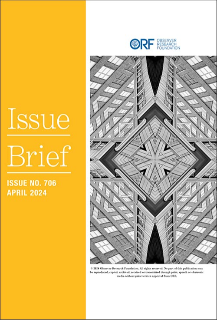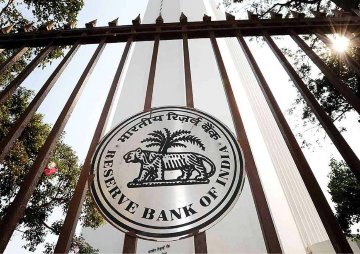Understanding inverted duty structure anomalies
It is widely held that an inverted duty structure (IDS) results from inputs having a higher tariff over the output, such that importing becomes preferable over domestic production. This report argues that without giving consideration to the production process—in particular, the product input mix and the quantities that go into the production of one unit of output—merely comparing tariffs of inputs over outputs can mislead the identification of IDS. Comparison of tariffs also needs to go beyond the basic customs duty. This paper provides an important platform for policymakers, businesses, industry representatives, multilateral organisations, and the academe, facilitating discussion on IDS and the anomalies around it and encouraging the formulation of evidence-based policy.
Introduction
What should the Indian government do to improve the competitiveness of the country’s manufacturing firms? Among various suggestions, the correction of inverted duty (tariff) structure (IDS) makes it to the priority list.
The question is, What is ‘inverted duty structure’? In a book, titled, “South Asia’s Turn: Policies to Boost Competitiveness and Create the Next Export Powerhouse”, the World Bank recommends that “tariffs should be reduced on intermediate goods in the cases where they are higher than on final goods leading to an inverted tariff structure which discourages domestic manufacturing.”[i] While it may be tempting to conclude that a product is being affected from an inverted duty structure when tariffs on inputs are higher than those on output, this report argues that this is not always the case, and that duty inversion may not necessarily hold even when tariffs on inputs are higher than on output.[ii]
Inverted Duty: Beyond Simplistic Assumptions
For a product to be affected from an inverted duty structure, it is imperative to understand the production processes, including the input mix, to produce a given output. In particular, one has to know all the inputs along with the quantities that go into the production of a unit of output. This would include having information on the domestic and imported procurement of inputs used to produce a unit of output. Once knowledge on the production process has been gathered, the next step would be to draw on the duty structure of all the inputs and the output. Duty structure comprises of information on basic custom duty along with other duties such as special additional duty (SAD), counter veiling duty (CVD), education cess and secondary higher education cess (EC & HSEC), among others. Further, since India is signatory to trade agreements where member countries provide for preferential tariffs which would be below the Most Favoured Nations (MFN) tariff applied by the signatories to the World Trade Organization (WTO), it is important to also draw on the tariff status, i.e., import tariff, of the inputs and output as specified in the signed trade agreements. Since some of the duties are cenvatable, effective duty rate should be determined while drawing on the duty structure.[iii]
Understanding the details of the production process and duty structure helps evaluate one of the most important aspects of duty inversion: determining the cost of manufacturing per unit of output domestically, along with the cost of importing per unit of output. It also helps in collecting other information such as the share of imported and indigenous inputs in the total cost of inputs, and the cost impact of duty structure arising from the use of imported inputs. If the cost of manufacturing per unit of output domestically is greater than the cost of importing per unit of output, then the duty structure can provide insight on the driver(s) of such cost differences. For instance, it is possible that the cost difference is because CVD on inputs is higher when compared to the CVD on the output.
The above discussion can be illustrated with the example in Table 1, which shows that to produce output HS84771000, several inputs are required. The duty structure suggests the following: a. the basic custom duty on the inputs is either higher or equal to the basic custom duty on the output; b. a four-percent special additional duty (SAD) and 12.5-percent counter veiling duty (CVD) is applicable to all the inputs and output; and c. under India’s trade agreements, the output can be imported at a preferential duty while only some of the inputs enjoy a preferential duty. Since the basic custom duty on (some) inputs is higher than on the output, it would be tempting to conclude that duty inversion exists in the case of HS84771000.
|
Table 1. Input mix and duty structure to manufacture HS8771000
|
|
HS Code
|
Basic Custom Duty
|
SAD (Special Additional Duty)
|
CVD (Counter Veiling Duty)
|
Imported in India at a preferential duty under a trade agreement?
|
|
(1)
|
(2)
|
(3)
|
(4)
|
|
Output
|
|
84771000
|
5% |
4.0% |
12.5% |
Yes
|
|
Inputs
|
|
|
|
|
|
85372000
|
10.0% |
4.0% |
12.5% |
No |
|
85013310 & 85015290
|
5.0%
|
4.0%
|
12.5%
|
No
|
| 84122990 |
7.5.0% |
4.0% |
12.5% |
Yes
|
|
84135090
|
5.0% |
4.0% |
12.5% |
No |
|
84818090
|
5.0% |
4.0% |
12.5% |
No |
|
84812000
|
10.0% |
4.0% |
12.5% |
Yes
|
| 84834000 |
5.0% |
4.0% |
12.5% |
No
|
|
90319000 & 90269000
|
5.0% |
4.0% |
12.5% |
Yes |
| 84133090 |
10.0% |
4.0% |
12.5% |
No
|
| 84136010 & 84136090 |
5.0% |
4.0% |
12.5% |
Yes
|
| Source: Input required to produce a unit of output has been drawn from FICCI (2016).[iv] Figures in column 2, 3, 4 and 5 are only for illustrating the discussion in this article, and does not reflect the existing state of affairs. |
For several reasons, however, this may not necessarily be the case. For instance, duty inversion may not exist when the share of inputs (where the tariff is higher than on output) does not dominate the total cost of inputs such that the cost of importing the output is still greater than the cost of importing the inputs to manufacture the output domestically. Moreover, duty inversion may not exist when the share of inputs (where the tariff is higher than on output) dominates the total cost of inputs, and yet product varieties may overshadow the potential duty inversion impact of input dominance. For example, assume that HS84133090 is a dominant input for output HS84771000. However, for product HS84771000-A (which is a variety), HS84133090 is not a dominant input. Now assume that the tariff structure of HS84771000-A is identical to that of HS84771000.[v] In such a case, despite higher input tariff on HS84133090, product HS84771000-A may not necessarily be affected from inversion.
It should be noted that as long as the input structure for varieties do not change, i.e., the same inputs would be required to produce HS84771000 and HS84771000-A, the tariff structure across HS84771000 and HS84771000-A will not change. However, the altering composition of input mix may alter tariff obligations such that higher input tariffs may or may not lead to inversion. In cases where inputs or alternative substitutes to inputs are unavailable domestically, importing of such inputs is the only option, and that tariff on such inputs is greater than on output, inversion may be unavoidable in cases of input dominance. However, the variation in the inversion impact may vary as per the input dominance.
The above example shows that: a. a product may not be affected from duty even when tariffs are higher on inputs than on output; and b. duty structures for a given product may not be inverted across product varieties. Moreover, it is also possible that not all products within an industry are affected by inversion. For example, the American Chamber of Commerce in India, have stated that duty structures for medical devices are not inverted across the board, and have argued that it is mostly the critical life-saving medical devices for which there is an inverted duty structure.[vi]
The complexity in identifying duty inversion, as shown above, raises the question of whether it is appropriate to conclude inversion on the basis of a simplistic approach which assumes inversion when tariffs on input are higher than on output, while ignoring other aspects such as product varieties, share of product input mix and production processes, among others. Is it appropriate to conclude inversion for the entire tree, given branch heterogeneity?
The World Bank, in the above cited book, concludes that the medical equipment industry in India faces duty inversion as materials for medical equipment face a tariff of 7.5 percent while final goods face a tariff of five percent. Assuming that the conclusion of duty inversion in the medical equipment industry is based beyond simply comparing tariffs on inputs with output, the fact is that that duty structures for medical devices are not inverted across the board, as discussed earlier. Besides, inversion on some medical devices has been corrected,[vii] an effort which has also found support from the industry.[viii]
Moreover, the complexities in ascertaining inversion, as discussed above, explain the missing empirical evidence on the causal impact of inversion correction on productivity.
Conclusion
To unravel the mystery on inverted tariff structure, it is imperative to go beyond duty comparison. Given product heterogeneity (either a product variety or different products within an industry), attention has to be given to several aspects of a production process such as information on input mix, domestic and imported components of this input mix, duty structure of all the inputs and output, among others. Such information would determine the cost of manufacturing per unit of output domestically, along with the cost of importing per unit of output which in turn would signal the existence of inversion. Collection of data over a period of time would also enable researchers to undertake an empirical investigation to determine the causal impact of inversion correction on productivity. Empirical evidence would not only help in providing support to assertions that inversion discourages domestic manufacturing, or that correction of inversion would reap substantial benefits but would also facilitate evidence-based policymaking.
Natasha Agarwal is a research economist affiliated with World Education Foundation, Norway . The views expressed in this article are solely hers.
References
[i]Lopez-Acevedo, Gladys; Medvedev, Denis; Palmade, Vincent. 2016. South Asia’s Turn: Policies to Boost Competitiveness and Create the Next Export Powerhouse. South Asia Development Matters; Washington, DC: World Bank. (Accessible at https://openknowledge.worldbank.org/handle/10986/25094) License: CC BY 3.0 IGO.
[ii]The analysis in this report is based on the understanding that for a given level of technology at time , does the production of output for given inputs , suffer from IDS?
[iii] See Cenvat Credit Rules, 2004 (Central Board of Excise and Customs, Department of Revenue, Ministry of Finance, Government of India) for more details. The same can be accessed at http://www.cbec.gov.in/htdocs-cbec/excise/cxrules/new-cenvat-rules.
[iv]Federation of Indian Chambers of Commerce and Industry (FICCI). 2016. FICCI Survey on Inverted Duty Structure in Indian Manufacturing Sector. Technical Report.(Accessible at http://ficci.in/SEDocument/20375/FICCI-INVERTED-DUTY-Report-2016.pdf)
[v]For simplicity, assume that WTOs MFN import tariff holds for both the inputs and output under India’s trade agreements with partner countries.
[vi]American Chamber of Commerce in India (AMCHAM, India). 2015. Letter to Shri. ArunJaitley, the Honorable Minister of Finance. Accessible at http://www.amchamindia.com/wp-content/uploads/2015/04/Shri-Arun-Jaitley.pdf.
[vii] (1) Tariff Commission. 2016. Outcomes of Tariff Commission Study Reports. Accessible at http://tc.nic.in/outcomes%20of%20TC/Outcomes%20as%20on%2012%20May%202016.pdf. (2) Government of India, Ministry of Finance (Department of Revenue) Notification No. 5/2016-Customs, 19th January 2016, New Delhi, India. Accessible at http://www.cbec.gov.in/htdocs-cbec/customs/cs-act/notifications/notfns-2016/cs-tarr2016/cs05-2016. (3) Government of India, Ministry of Finance (Department of Revenue) Notification No. 4/2016-Customs, 19th January 2016, New Delhi, India. Accessible at http://www.cbec.gov.in/htdocs-cbec/customs/cs-act/notifications/notfns-2016/cs-tarr2016/cs04-2016.
[viii] ‘AIMED: Correction of Inverted Duty Structure and Quality Assurance – Talisman to Boost Confidence in Local Manufacturers’, 14th May, 2016, E-Health (The Enterprise of Healthcare). Accessible at http://ehealth.eletsonline.com/2016/05/aimed-correction-of-inverted-duty-structure-quality-assurance-talisman-to-boost-confidence-in-local-manufacturers/.
The views expressed above belong to the author(s). ORF research and analyses now available on Telegram! Click here to access our curated content — blogs, longforms and interviews.

 PDF Download
PDF Download



 PREV
PREV


